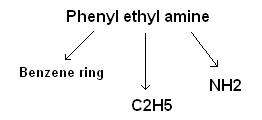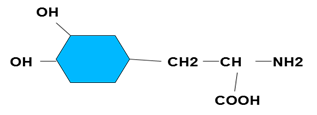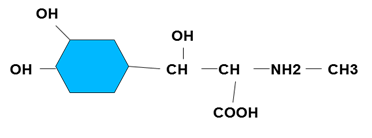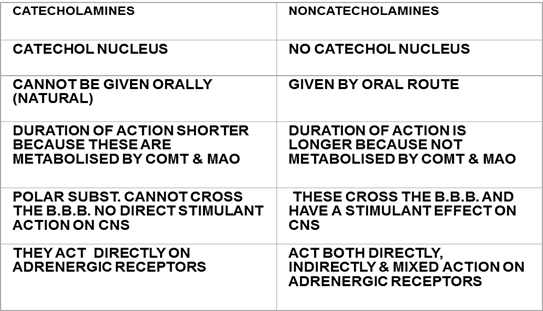Symphathomimetics mimic the effects of sympathetic system. Two types of receptors are present:
- Alpha receptors
- Beta receptors
All sympathomimetics act through these receptors; acting either on one type of both, depending upon the selectivity and intrinsic activity i.e. how powerfully they stimulate the receptors (acting as agonists, partial agonists, etc.)
There are various subtypes of receptors i.e. α1, α2, β1, β2, etc.
As a general rule,
Most of the time α2 receptors are present presynaptically, while in the periphery post synaptic receptors are mostly α1.
β1 receptors are present in the heart, while β2 elsewhere.
Among muscarinic receptors, M2 are present in the heart while M1 occur elsewhere.
Among nicotinic receptors NN are present in neural tissue and ganglia while NM are found in the neuromuscular junction.
We classify the drugs as it is impossible to remember every drug. Classification is based on the common properties.
Based on Chemistry:
Basic structure common to all sympathomimetics
Neurotransmitter is formed by active transport of amino acid (tyrosine).
Tyrosine is converted into dopa by tyrosine hydroxylase.
Dopa is converted into dopamine
Dopamine is transported into storage vesicles where beta hydroxylase converts it into noradrenaline.
Methyl transferrase adds a CH3 group to form adrenaline.
Adrenaline acts equally on both α1, α2 and β1 and β2 receptors, while noradrenaline acts more on the α receptors while less on β1 and far less on β2 receptors.
The position 3 and 4 in the benzene ring are important, if hydroxyl group gets attached to these positions, then the structure is called catechole nucleus and the substances are termed catecholamines. If hydroxyl group at either of these two locations is missing, the substance is not catecholamine.
This special structure confers special properties to the compounds;
- they become polar and cannot cross the blood brain barrier
- They become the substrate for catechol-o-methyl transferrase which is abundant in the GIT and liver.
Thus these drugs;
- Cannot be taken orally
- Have a short duration of action
Substitution on amino group
As the alkyl substitution on amine radical is increased, the activity on β receptors increases. Greater the substitution on amine radical, greater is the β activity, while α activity is reduced. (Isoprenaline has pure β activity, epinephrine has lesser and nor epinephrine has least).
Substitution on Alpha carbon
Substitution at α carbon atom confers the ability to resist monoamine oxidase (MAO), greater substitution, greater is the ability, thus drugs are less rapidly metabolized (e.g. amphetamines, amphedrines). Also the ability to displace catecholamines from storage sites is increased. Also called phenylisopropylamines.
Substitution on Beta carbon
Directly acting agonists (e.g. epinephrine, NE but not dopamine). Facilitation of adrenoceptors occurs
Based on the catechol nucleus, sympathomimetics are classified into:
- Catecholamines
- Non-Catecholamines
Catecholamines:
1. Natural:
Adrenaline β1= β2, α1= α2
Noradrenaline β1>> β2, α1= α2
Dopamine D1= D2>> β>>>> α
2. Semi-Synthetic
Dobutamine β1
3. Synthetic
Isoprenaline β1= β2
Non-Catecholamines
1. Natural
2. Synthetic
a. Non selective
(Not selective for receptors, act on both α and β receptors, but have a greater effect at α receptors, this is concentration dependent, at higher concentration the selectivity might be lost)
Amphetamines, Metamephetamine, Dextroamphetamine, Methyl phenidate
b. Selective α adrenoceptor stimulants
Methoxamine, Phenyl ephrine (alpha 1), Metaraminol, Midorine (alpha 1)
Xylometazoline and oxymetazoline are direct alpha agonists used as decongestants due to vasoconstriction effect (having clonidine like effect)
c. Selective β1 adrenoceptor stimulants
Orciprenaline
d. Selective β2 adrenoceptor stimulants
Salbutamol, Terbutaline, Pirbuterol, Bitolterol, Salmetrol, Ritodrine
e. Selective β1 adrenoceptor stimulants
Prenalterol (some members decrease blood pressure)
f. Selective α2 stimulants
Clonidine, Apraclonidine (used in open angle glaucoma), Brimonidine, Dexmetomidine, α methyl dopa, Guanabenz, Guanfaciene
g. D1 agonists
Fenoldopam (renal vasculature vasodilator, reduces blood pressure)
h. D2 agonists
Bromocryptine
Type of Action
- Certain drugs directly stimulate the receptors
- Others act indirectly by release of noradrenaline
- Some act either directly or indirectly
Catecholamine vs. Noncatecholamines
Therapeutic classification Sympathomimetics
Used as bronchodilators
salbutamol, terbutaline, salmetrol, adrenaline,
Used for treatment of anaphylaxis
Used In the Treatment of Hypotensive Shock
Dopamine, Methoxamine, Phenylephrine
Used as cardiac stimulants
adrenaline, isoprenaline
Used as nasal decongestants
phenylephrine, xylometazoline, phenylpropanolamine, naphazoline
Used to prolong the effect of local anesthetics
adrenaline, phenylephrine
Used as uterine relaxants
salbutamol, isoxsuprine, ritodrine
Used in the treatment of narcolepsy
amphetamines, methyl amphetamine, dexamphetamine, ephedrine, methylphenidate modafinil
Used as mydriatics
adrenaline, phenylephrine
As anorectics
amphetamines, fenfluramine, phenmetrazine
Used in open angle glaucoma
Dipevefrin, adrenaline, apraclonidine, brimonidine
Used in attention deficit hyperkinetic disorder
Methylphenidate, amphetamines, modafinil
 howMed Know Yourself
howMed Know Yourself












